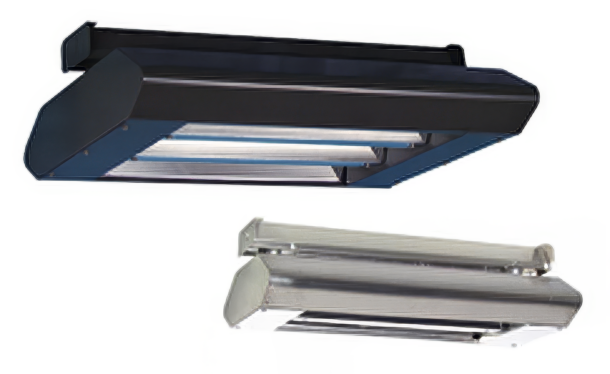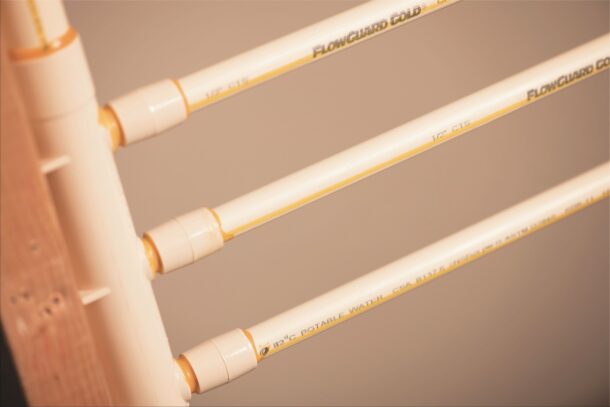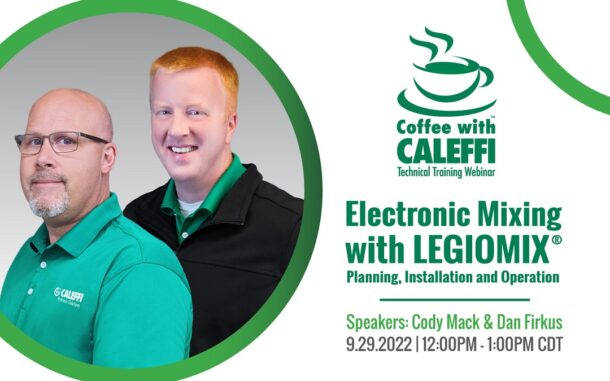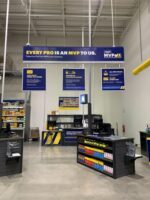Accessory Provides Unobstructed Sightlines and Optimizes Heater Performance in Occupant Areas Marley Engineered Products (MEP), a leading choice among contractors for comfort heating and ventilation systems, has launched a new accessory for its line of infrared heaters to enhance comfort while providing unobstructed sightlines in occupant spaces. The Agency Listed Recessed Trim Kit enables MEP’s infrared heaters Read more
ShopTalk

Accessory Provides Unobstructed Sightlines and Optimizes Heater Performance in Occupant Areas
Marley Engineered Products (MEP), a leading choice among contractors for comfort heating and ventilation systems, has launched a new accessory for its line of infrared heaters to enhance comfort while providing unobstructed sightlines in occupant spaces.
The Agency Listed Recessed Trim Kit enables MEP’s infrared heaters to be recessed completely into a ceiling to reduce the intrusive nature of overhead heating units and improve the aesthetics of any space. From high-end patios and hotel and lobby valet areas to other commercial spaces with overhangs, the accessory allows infrared heat to be used without the consequence of wind or inclement weather adversely affecting the heaters’ ability to provide hidden, comfortable and cozy heating.

“This Trim Kit is designed to provide a clean and finished look to heating installations while optimizing the performance of the heater,” explained Sharon Murphy, Senior Product Manager with Marley Engineered Products. “Providing enhanced heating efficiency, noise reduction, space-saving advantages and an aesthetically pleasing appearance, among other benefits, it is a valuable addition to any commercial building that prioritizes occupant comfort while also providing freeze protection and snow melting.”
Ideal for indoor/outdoor, total or spot-heating use, MEP offers radiant heaters with two-element or three-element designs for flexible sizing and concentrated heat in a single infrared unit. The heaters optimize short-wave infrared heat – which heats objects instead of the air around the heater – through heavy-gauge gold anodized reflectors. These reflectors allow for more than 60 percent of heat to be generated while the heating element itself accounts for the other 40 percent – meaning high-performance heating is matched by energy efficiency.
“Our infrared heaters feature cost-saving benefits and technological advancements that make a huge impact – no matter the application,” added Murphy. “They offer the ease of installation contractors prefer and the warmth and dependability that their customers require to warm icy cold entryways and keep blustery winds at bay.”
To reduce handling and installation times, the Trim Kit package features single-carton packaging and a trim ring installation bracket. The trim ring is offered in a variety of colors to match ceilings and complement a building’s appearance.
To learn more about the Recessed Trim Kit and MEP’s infrared heaters, visit www.marleymep.com.

By Jonathan Simon In plumbing, like many trades, knowledge is often shared plumber-to-plumber in the field. That allows experience to get passed from one generation to the next. But sometimes the information shared doesn’t keep up with new developments or, like a childhood game of “telephone,” gets distorted over time and becomes inaccurate. The result Read more
By Jonathan Simon
In plumbing, like many trades, knowledge is often shared plumber-to-plumber in the field. That allows experience to get passed from one generation to the next. But sometimes the information shared doesn’t keep up with new developments or, like a childhood game of “telephone,” gets distorted over time and becomes inaccurate. The result is the proliferation of “myths” that are accepted as true by some but are provably false. Here are five myths related to CPVC plumbing systems that the FlowGuard Gold® CPVC team has encountered in the field–and the truth behind the myth.
Myth 1: CPVC should be replaced when it shows signs of discoloration
It’s easy to see how some myths get started. A plumber may think that discoloration is an indication of structural weakness, decides the pipe needs to be replaced and passes that “tip” onto a younger plumber.
But older CPVC pipes that show signs of discoloration do not need to be replaced. CPVC naturally becomes more rigid as it ages and may discolor, but these factors do not increase the risk of failure in a properly installed and serviced system. In fact, the pressure-bearing capability of CPVC pipes improves with age, so, by that measure, an older CPVC pipe is actually stronger than it was when first installed.
It is recommended that plumbers use C-style cutters, a wheel cutter, or a fine-tooth saw when servicing older CPVC pipes, but there is no reason to remove the pipe from service due to discoloration. One of CPVC’s strengths is the material’s long service life—some of the first CPVC pipes ever installed back in the 1960s are still in service today–and discoloration is not a reason to shorten that service life.

Myth 2: CPVC is difficult or slow to install
Some myths are rooted in misperceptions and false assumptions while others can be traced to competitors seeking to gain traction in a competitive market. The myth that CPVC is difficult to install falls into the second category.
CPVC plumbing systems are similar to copper in their design. Both are rigid systems that use socket-style fittings in which the pipe fits into the fitting. But CPVC is easier to work with than copper and the solvent welding process used to bond CPVC pipes and fittings is simple, easy to learn and does not require any special tools. CPVC plumbing systems install faster than copper and have installation times that compare favorably to PEX systems.
Independent research studies that measured installation times for CPVC and PEX systems found that CPVC trunk-and-branch systems install up to 17% faster than comparable PEX trunk-and-branch systems. A PEX mini-manifold system installed 10% faster than a CPVC trunk-and-branch system but used 21% more pipe and the added material costs outweighed the time savings. Most plumbers with experience using both materials have reported no noticeable speed difference between CPVC and PEX plumbing systems.
Myth 3: CPVC can’t handle higher pressures and temperatures
A review of material specifications will quickly dispel this myth. Plumbing codes require that domestic water plumbing systems be capable of handling at least 100 psi of pressure at 180°F without ballooning or bursting. FlowGuard Gold pipes and fittings not only meet this requirement but are pressure rated to 400 psi at room temperature and above 200 psi at all temperatures up to 140°F. When subjected to extreme quick-burst testing, a solvent-welded FlowGuard Gold CPVC plumbing system will not typically fail until the system reaches pressures of 1200 psi or higher.
In addition, CPVC isn’t subject to additional temperature and pressure limitations imposed by chlorinated water on other plastic plumbing systems (140° F and 80 psi). That makes CPVC ideal for higher temperature applications such as hot water lines. It can even support legionella mitigation strategies that store water above 140°F. In multi-story buildings, CPVC’s excellent pressure rating enables use of gravity-fed distribution systems and booster pumps that can introduce risks to other plastic plumbing systems.
Myth 4 CPVC is not as sustainable as other plumbing systems
You might expect a plastic piping system like CPVC to be less sustainable than a metal system like copper, but CPVC has excellent sustainability credentials.
FlowGuard Gold CPVC requires less energy to manufacture and produces fewer greenhouse gases over its service life than PEX and copper systems. The material’s long service life, enabled by its chlorine immunity, means less material is ultimately required to support the application. Plus, CPVC is recyclable through proper centers.
FlowGuard Gold CPVC is also the only residential plumbing system certified by Home Innovation Labs National Green Building Standard (NGBS) and has a lifecycle assessment to contribute to LEED certification.
Myth 5: CPVC is more expensive than other plastic plumbing systems
Plumbers who haven’t compared material costs can be forgiven for believing CPVC is one of the more expensive plumbing systems. After all, FlowGuard Gold CPVC is the only material in the industry that offers a warranty that isn’t voided by exposure to chlorinated water, putting it in a class by itself. It doesn’t make sense that it should be less expensive, but it is. According to a cost study done by a leading PEX manufacturer, CPVC material costs were half the cost of their own PEX system.
These savings come from two key areas: fittings and pipe sizing. While a PEX system contains about 30% fewer fittings than a CPVC system, those fittings (and the crimp, cinch or expansion rings that go with them) typically cost 3-5 times more than the comparable CPVC fitting. In addition, because those insert fittings introduce significant pressure drop at ½” diameters, PEX systems are typically upsized to use more 1” and ¾” pipe than required with a CPVC system, saving even more money. You can verify this yourself by comparing PEX and CPVC costs on your next job.
Better Information Leads to Better Service
Plumbers looking to deliver the best service to their customers and grow their business should be careful not to take everything they hear at face value. There are resources available that provide reliable information about plumbing systems, including manufacturer websites. To get more information on CPVC, visit the plumber’s resource center on the FlowGuard Gold website.

Optimal heating system design combines best practices on both sides of the flange. Designing, installing and maintaining perfect loops ensures that we deliver superior comfort, energy efficiency and reliability to our customers. Back by popular demand, Max Rohr welcomes Grundfos industry expert Brent Cunningham from The Perfect Loop training series to discuss hydronic heating systems Read more
Optimal heating system design combines best practices on both sides of the flange. Designing, installing and maintaining perfect loops ensures that we deliver superior comfort, energy efficiency and reliability to our customers. Back by popular demand, Max Rohr welcomes Grundfos industry expert Brent Cunningham from The Perfect Loop training series to discuss hydronic heating systems at the next Coffee with Caleffi™ webinar on Thursday, Oct. 20 in an extended edition from 12 noon – 1:30 p.m. CDT.

Cunningham is Grundfos HVAC OEM Business Development Manager serving as a sales engineer in the commercial and OEM business units. He enjoys cycling, running, skiing and other outdoor activities.
Rohr is Caleffi Education and Industry Engagement Manager leading industry connections with trade associations, committees, industry initiatives and collaborative manufacturer partners. He describes himself as an “energy nerd.”
The monthly educational webinars are free and are intended for engineers, contractors, designers and wholesalers. A Certificate of Attendance is emailed to attendees following the event for continuing education audits.
Please visit our website at www.caleffi.us for schedule details or register here today.

Electronic mixing valves are a rapidly growing technology for domestic hot water systems. The reliability and serviceability of the Caleffi LEGIOMIX® make it a great fit for new construction and replacement work. How can engineers and plumbers best utilize the latest in electronic mixing valve technology? What tips from the design and installation phases help Read more
Electronic mixing valves are a rapidly growing technology for domestic hot water systems. The reliability and serviceability of the Caleffi LEGIOMIX® make it a great fit for new construction and replacement work. How can engineers and plumbers best utilize the latest in electronic mixing valve technology? What tips from the design and installation phases help streamline the process? Cody Mack and Dan Firkus will walk the Coffee with Caleffi™ audience through this emerging sector of mixing valves at the next webinar on Thursday, Sept. 29 from 12 noon – 1:00 p.m. CDT.

Mack has nearly 20 years’ experience as installation contractor, service technician, application engineer, training manager and now product manager for Caleffi. Our audience will appreciate his thoughtful yet humorous content delivery combined with his practical, common sense product approach.
Firkus has 25 years’ of field experience as an installation contractor plus three years of application engineer experience at Caleffi, assisting wholesalers, engineers and installers. Recently promoted to OEM Sales Manager, his well-rounded and realistic technical background provides a firm foundation for our audience.
The monthly educational webinars are free and are intended for engineers, contractors, designers and wholesalers. A Certificate of Attendance is emailed to attendees following the event for continuing education audits.
Please visit our website at www.caleffi.us for schedule details and registration.

The Lowe’s MVPs Pro Rewards and Partnership Program is a new approach that flips traditional loyalty programs on their heads to deliver real solutions and benefits Pros need to succeed. The new program comes at a time when 90% of Pros say it’s important that retailers have valuable loyalty programs, and according to new findings from Lowe’s, Pros also voiced Read more
The Lowe’s MVPs Pro Rewards and Partnership Program is a new approach that flips traditional loyalty programs on their heads to deliver real solutions and benefits Pros need to succeed. The new program comes at a time when 90% of Pros say it’s important that retailers have valuable loyalty programs, and according to new findings from Lowe’s, Pros also voiced the need for retailers to bring more than rewards to the table.

Lowe’s MVPs Pro Rewards, available in select regions and nationwide gives Pros a committed business partner in Lowe’s. Complementing Lowe’s strong credit offerings (5% off every day on eligible purchases, to 0% interest for 60 days for Lowe’s Business Advantage accounts), Lowe’s MVPs Pro Rewards offers new and existing loyalty members benefits including:
- Lowe’s e-gift cards earned when Pros spend in-store and online on eligible purchases**
- Access to business resources helping Pros tackle back-of-house operations
- Exclusive offers for rewards on eligible paint purchases** and free select snacks or drinks** at Lowe’s stores
- A chance to win incredible prizes like Ford F-Series trucks that serve as many Pros’ mobile offices and custom-built local advertising packages***
- A simple mobile and online user experience allowing Pros to track and claim rewards even when sending a crew member into the store
- And, coming soon, MVPs Bonus Points that can be used for additional exciting rewards helping Pros invest in their businesses and themselves

“We’re deepening our partnership with Pro customers because when they succeed, we succeed,” said Tony Hurst, Senior Vice President Pro, Services and International. “Lowe’s MVPs Pro Rewards is another big step in Lowe’s continued Total Home strategy when it comes to the important Pro customer. We are committed to a true business partnership mindset to help Pros as they grow their businesses and their futures.”
Nearly 90% of Pros say it’s important for retailers to have valuable loyalty programs as Pros also voiced the need for retailers to offer solutions to propel their business forward, according to Lowe’s first annual Lowe’s State of the Pro report, found online at Lowes.com/StateOfThePro. An industry-leading study, the report contains insights from Pros and their customers, detailing the state of the home industry and trends in homeowner improvement plans, and priority projects in 2022.
For more information on the latest for Pros, please visit Lowes.com/Pro.
